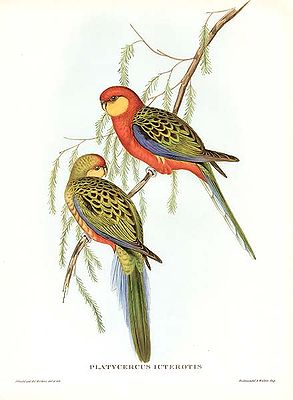Stanley's Parakeet
| Stanley's Parakeet | ||||||||||||
|---|---|---|---|---|---|---|---|---|---|---|---|---|

Stanley's Parakeet ( Platycercus icterotis ) |
||||||||||||
| Systematics | ||||||||||||
|
||||||||||||
| Scientific name | ||||||||||||
| Platycercus icterotis | ||||||||||||
| ( Kuhl , 1820) |

The Stanley's Parakeet ( Platycercus icterotis ) belongs to the parrot species , genus flat-tailed parakeets . Because of its coloring, the bird is also called the yellow-cheeked parakeet or yellow-cheeked rosella . There are two subspecies, P. icterotis icterotis and the Red-backed Stanley's Parakeet ( P. icterotis xanthogenys ), which differ in color.
description
With a size of up to 26 centimeters, the birds weigh between 55 and 80 grams. Stanley's Parakeets show significant sex differences .
The head and chest plumage of the male bird in P. icterotis icterotis is scarlet with yellow cheek spots. The back feathers are black and have a yellow-green or red border. The wing feathers are colored blue, the wing covers are black with a green border. The coloring of the male in P. icterotis xanthogenys is less pronounced and paler, the wing feathers are dark gray.
The main color of the female bird in both subspecies is green-brown with some blue feathers. The plumage on the head and chest shows sprinkles of red color. The cheek spots are only weakly pronounced and do not reach the eye.
All adult animals have brown eyes and gray legs, the beak is light gray.
The young birds are mostly green in color, the cheek spots of the adult Stanley's Parakeets are only vaguely recognizable.
Occurrence, way of life and diet
Stanley's Parakeets are native to southwest Australia. They prefer grasslands loosely covered with trees or open forests. The birds, which are not endangered according to the Red List, have developed into cultural successors in some areas . In general, however, Stanley's Parakeets are not very common birds. Their distribution is uneven and patchy. The population density is subject to great regional fluctuations. The main distribution area today is the far south-west of Australia, where this species has probably benefited from the clearing of the eucalyptus trees and the creation of agricultural areas. In contrast, the population in the Wheatbelt has collapsed dramatically and in some cases has completely died out. Compared to the ringed parakeet occurring in the same area of distribution , whose subspecies Barnardius zonarius semitorquatus is larger and, above all, significantly heavier, the parakeets cannot prevail. This species of collar-necked parakeet competes with the Stanley's Parakeet for both nesting sites and food resources.
The pairing of Stanley's Parakeets is often lifelong with close ties between the partners. The birds live in small family groups and flocks of up to 25 animals.
Stanley's Parakeets feed on seeds, fruits, herbs and insects. They pick up small stones to aid digestion.
Reproduction
Stanley's Parakeets reach sexual maturity at twelve months. The nest is usually created in a tree hole. The clutch comprises three to seven eggs. The breeding occurs exclusively by the female. The young hatch after an incubation period of 20 days. They fledge after about 35 days.
supporting documents
Individual evidence
literature
- Joseph M. Forshaw : Australian Parrots. 1st German-language edition. Volume 2, Arndt-Verlag, Bretten 2003, ISBN 3-9808245-2-7 .
